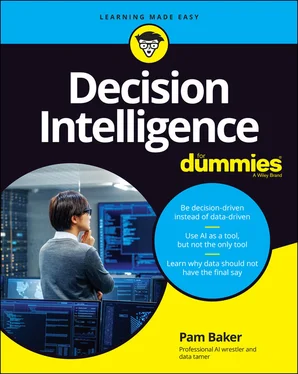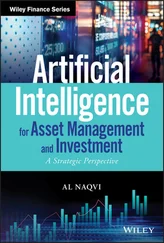This book takes a studied approach to having you reimagine the decision-making, by focusing on a set of discrete tasks you need to accomplish. Here are those tasks, in no particular order:
Flip the data mining model from data first to data last. You start with a decision aimed at the best possible business outcome and end with the data and the processes you need to bring about that outcome in the real world.
Rebalance human and machine roles. Decision intelligence calls for a redirection from a data driven to a decision driven organization. This framework clearly casts humans as decision-makers, where AI acts as sidekick, and where data is relegated to a supporting actor.
Map changes caused by putting the decision first in terms of Business impact Processes Tools Business and Ethical Principles Teams
Learn decision theory and a multidisciplinary approach to decision-making: You learn which steps you must take in order to succeed with decision intelligence, from new perspectives on Business impact AI projects Upstream and downstream decisioning Disruptive innovation Job roles
This book answers your questions about what decision intelligence is, which conditions must be created at your company in order for it to succeed, how you can plan a project, and how to implement it successfully. I've also made an effort to ensure that this book can be used in myriad ways and by anyone, from individuals to powerful leaders of huge organizations. As such, it offers these benefits:
An overview of the steps involved in putting the decision before the data in the decision-making process
A guidebook with practical suggestions for the various options, overall flexibility, and choices of implementations of a decision intelligence strategy
A reference book divided into parts, chapters, and sections so that you can quickly find the content you’re looking for when you need it
This book — designed so that you can swiftly get a grasp on everything — features many examples, instructions, checklists, illustrations, and tables. It’s also structured systematically according to the decision intelligence framework and its many moving parts.
Conventions Used in This Book
This book doesn’t have many rules. The entire book is structured so that you can quickly find everything you need and get a grasp on the content. The detailed table of contents helps you jump right to the information you need, and each chapter begins with a brief and succinct description of the chapter's main topics. Whenever topics overlap or other chapters are mentioned, cross-references help you conveniently jump back-and-forth between the chapters. If you’re interested in a particular term, you can look it up in the index.
This book is not (only) for decision-makers in business or finance. Decision intelligence is too crucial for improving business outcomes to be contained only to the C-suite and data scientist levels. In organizations that practice or seek data- and AI-democratization, decision intelligence should be practiced at every level of decision-making throughout the organization, even at the microdecision and mundane-decision levels. Whether you work at a company, an educational institution, a research institute, a public agency, or a nonprofit organization, you can benefit from the decision-driven approach that is at the heart of decision intelligence. Whether you have an education in the technical, economic, management science, or social science fields, this creative approach gives you new ideas on how to use what you know (and what you have to decide) more productively.
On an individual level, the following assumptions are made in this book about readers who will most likely gain the most from the information in this book:
You’re in charge of an organization or department and you want to be decision driven instead of data driven so that every decision is productive and profitable.
You’re trying to accelerate your career plans and you want to shine by making important decisions so that the best possible outcome is realized.
You are applying, or you are planning to apply, AI or machine learning at your organization, and you need to know how to make projects succeed in terms of measurable business impacts.
Your company is already working with data-driven methods and falling well short of your organization’s goals and expectations. You want to enhance or replace your previous work with new methods, tips, and tricks for improving its implementation, and you want a guide on how to make it work and perform consistently well over time.
You don’t need to have any specific skills for this book — you only have to be curious and intent on making good decisions — every time.
What You Don’t Have to Read
It’s worth your time to read the entire book. You can find important tips everywhere in it. Even if you can use only a few of its suggestions, the time and money you invest will be worth it. I guarantee that you’ll be able to use more than just a few elements of this information in your private life, your career, and your organization — regardless of your job role or your experience in decision-making. Some of the text in this book appears in a gray box, in order to highlight background information. You don’t absolutely need this info, but it’s always helpful.
How This Book Is Organized
This book is organized into six distinct parts, as described in this section. The design is intended to help you break free of any brain ruts and consider new ways of thinking about making decisions based on a variety of perspectives.
Part 1: Getting Started with Decision Intelligence
This section gives you an overview of the principles and methods in the decision intelligence framework. You can find out why being decision driven outperforms being data driven. You can also learn how to create the necessary conditions for decision intelligence projects to succeed at your organization, how to plan a project, and how to reinvent what it means to have an actionable outcome.
Part 2: Reaching the Best Possible Decision
The first phase of the decision intelligence process is all about making the decision from which you build the steps and then choosing the tools and data to realize the result of that decision in the real world. Shaping the decision, mapping a path, and choosing the right tools are essential to creating the best possible outcome. At the conclusion of deciding the impact you seek lies the beginning of the questions to be answered.
Part 3: Establishing Reality Checks
In the decision intelligence framework, you need to start with a decision, but that decision must be rooted in reality, and it must be attainable. In other words, this isn’t the place for pipedreams, even if profoundly creative disruption is your goal. To keep things grounded, you simply have to take the measure of job roles and team skill diversification, play to both human and machine strengths, ensure that decisions you intend to automate at large scales actually work at scale, among other reality checks. You can’t manage — or make a reality — that which you can’t measure. Be sure to measure the important things and skip the unimportant to ensure your decision (as well as its expected impact) is solid.
Part 4: Proposing a New Directive
Decision intelligence has many uses and is heavily based on ideas tied directly to favorable outcomes. As such, it plays a significant role in the Idea Economy, in impacts on entire industries, and in building competitive advantage for organizations, governments, and economies. In short, disruption is the point, change is constant, and you can use decision intelligence to command or at least direct both.
Читать дальше












